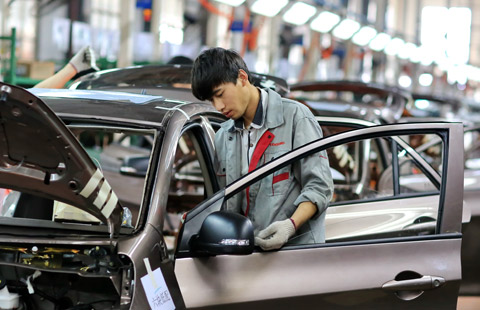Chinese adapt to changes in job market
BEIJING - Working in a small village in China's Hubei province, Su Tao lives a life that is atypical when compared with his college classmates.
Upon graduation, Su passed a test allowing him to work at a water management station in a poor village plagued by water shortages. By helping local residents fix pipes and look for water sources, Su felt a sense of achievement like never before.
"Few of my classmates had the chance to work at the grassroots," Su said. "It is just great to feel needed here."
Su is one of the 25,000 college graduates that go to the country's poorest areas every year to support local development. The program, first launched in 2006, allows the educated work force to assist with rural development in fields such as agriculture and education, while also helping fresh graduates find jobs.
Such a program is just one example of how the Chinese authorities are working to keep employment stable during a time of structural change. While official unemployment data points to an optimistic outlook, China's job market faces many challenges.
One of the pressing issues is the rising amount of inexperienced labor coming into the work force. Fresh college graduates will hit a historical high of 7.95 million in 2017, accounting for more than half the new labor force.
More than 3 million rural laborers have moved into the cities, leading for calls for more jobs in urban areas to meet demand.
China's structural reforms also come with pain. China will have to relocate 500,000 laid-off workers from glutted industries such as steel and coal, an arduous task requiring determination and intelligence.
"There are certainly many structural problems in the job market," said Lu Aihong, spokesperson of the Ministry of Human Resources and Social Security. "We will continue to make stable employment our top priority."
Authorities have rolled out an array of pro-employment policies. Fiscal funds totalling 100 billion yuan ($14.5 billion) were set aside to assist the resettlement of workers laid off due to the overcapacity cut, while special programs were launched to give graduates more job opportunities.
The government helped 720,000 laid-off workers find new jobs last year.
While job fairs and special programs help satisfy demand in the job market, experts say a more sustainable pattern to ensure stable employment is the increase of supply.
Entrepreneurship is a buzzword of the government agenda, not only because for its role as a growth driver, but also as a job creator. A guideline on entrepreneurship and employment released recently by the State Council encouraged young migrant workers to start their own businesses, and offered favorable tax terms for innovative companies that create jobs.
"China's economy is in the middle of transition. As new growth engines replace the old, the changes in labor structure are inevitable," said Liu Yanbin, director of the Chinese Academy of Labour and Social Security, a government think tank.
"Policies that promote employment should be consistent with the structural changes taking place in China, balancing supply and demand in the job market," Liu said.
As China's manufacturing sector gradually moves up the value chain, professional training should be given to increase the supply of highly skilled workers.
Su Tao will undoubtedly become a skilled plumber by the time he leaves the village. After one year at the water management station, Su plans to apply to be a civil servant. The government will offer people like Su favorable terms, giving them a competitive edge as a reward for their experience.
"As a civil servant, I can have a more stable job," he said.























